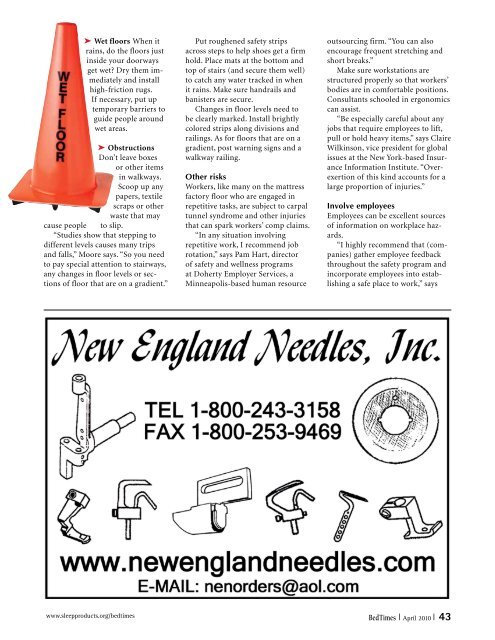You also want an ePaper? Increase the reach of your titles
YUMPU automatically turns print PDFs into web optimized ePapers that Google loves.
➤ Wet floors When it<br />
rains, do the floors just<br />
inside your doorways<br />
get wet? Dry them immediately<br />
and install<br />
high-friction rugs.<br />
If necessary, put up<br />
temporary barriers to<br />
guide people around<br />
wet areas.<br />
➤ Obstructions<br />
Don’t leave boxes<br />
or other items<br />
in walkways.<br />
Scoop up any<br />
papers, textile<br />
scraps or other<br />
waste that may<br />
cause people to slip.<br />
“Studies show that stepping to<br />
different levels causes many trips<br />
and falls,” Moore says. “So you need<br />
to pay special attention to stairways,<br />
any changes in floor levels or sections<br />
of floor that are on a gradient.”<br />
www.sleepproducts.org/bedtimes<br />
Put roughened safety strips<br />
across steps to help shoes get a firm<br />
hold. Place mats at the bottom and<br />
top of stairs (and secure them well)<br />
to catch any water tracked in when<br />
it rains. Make sure handrails and<br />
banisters are secure.<br />
Changes in floor levels need to<br />
be clearly marked. Install brightly<br />
colored strips along divisions and<br />
railings. As for floors that are on a<br />
gradient, post warning signs and a<br />
walkway railing.<br />
Other risks<br />
Workers, like many on the mattress<br />
factory floor who are engaged in<br />
repetitive tasks, are subject to carpal<br />
tunnel syndrome and other injuries<br />
that can spark workers’ comp claims.<br />
“In any situation involving<br />
repetitive work, I recommend job<br />
rotation,” says Pam Hart, director<br />
of safety and wellness programs<br />
at Doherty Employer Services, a<br />
Minneapolis-based human resource<br />
outsourcing firm. “You can also<br />
encourage frequent stretching and<br />
short breaks.”<br />
Make sure workstations are<br />
structured properly so that workers’<br />
bodies are in comfortable positions.<br />
Consultants schooled in ergonomics<br />
can assist.<br />
“Be especially careful about any<br />
jobs that require employees to lift,<br />
pull or hold heavy items,” says Claire<br />
Wilkinson, vice president for global<br />
issues at the New York-based Insurance<br />
Information Institute. “Overexertion<br />
of this kind accounts for a<br />
large proportion of injuries.”<br />
Involve employees<br />
Employees can be excellent sources<br />
of information on workplace hazards.<br />
“I highly recommend that (companies)<br />
gather employee feedback<br />
throughout the safety program and<br />
incorporate employees into establishing<br />
a safe place to work,” says<br />
BedTimes | April 2010 | 43

















